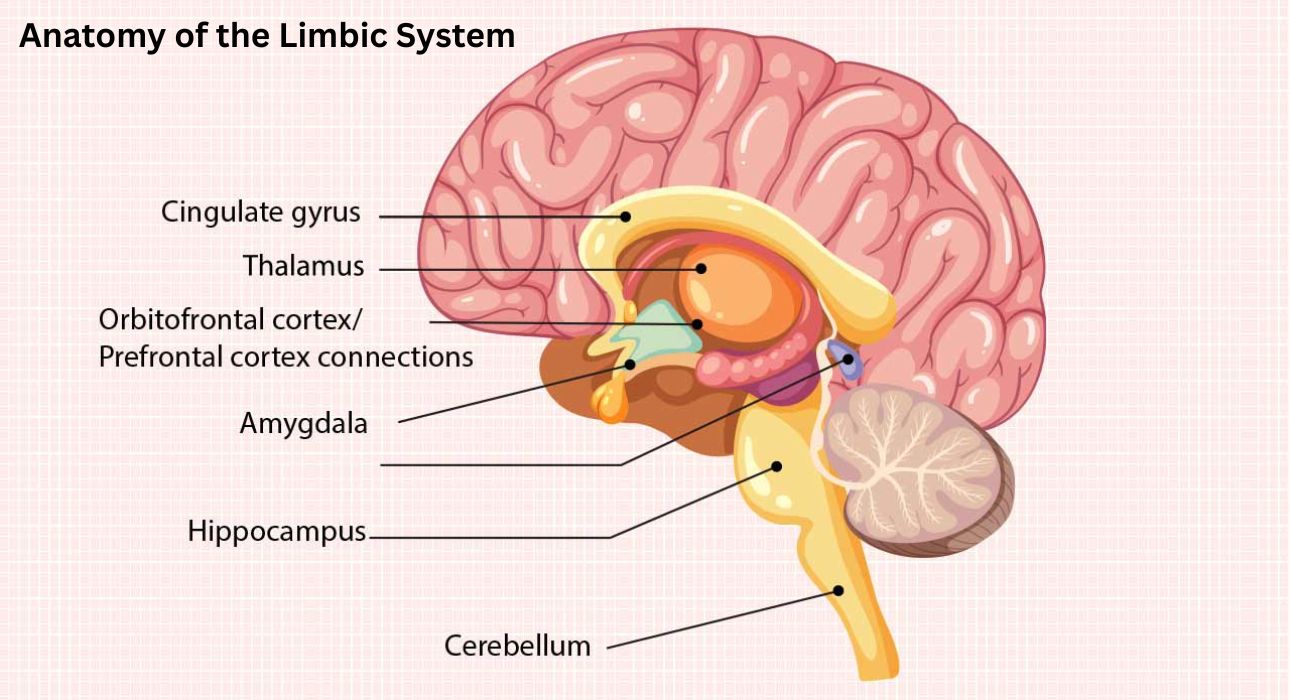This article examines the capacities of the limbic framework within the feeling and behaviour of man. The limbic system consists of a collection of interconnected structures in the brain that are particularly known to contribute to emotional response and its biological basis, memory formation, and behavioural control. The overall anatomy and function of the structures that the article describes shall give an overview of how these emotions are generated, processed, and expressed.
In methodology, the article is a synthesis of a wide range of literature in neurosciences from history, theoretical models, and data from modern neuroimaging techniques such as fMRI and PET scans. This interdisciplinary work gives a detailed understanding of the structural and functional aspects involved in the limbic system.
The results indicate the functions of amygdala in threat detection and fear response, that of hippocampus in contextual memory and emotional learning, and hypothalamus in autonomic regulation and hormonal control of emotional states. The functions shown for cingulate gyrus, thalamus, and orbitofrontal cortex further demonstrate how the limbic structures shape the engagement of a complex emotional world and behavioral output.
Theoretical counteraccusations of these studies reach far into clinical psychology, psychiatry, and practice. Disorders of anxiety, depression, post-traumatic stress disorder, and schizophrenia, for instance, have all been shown to be related to dysfunction within the limbic system. Once the dysfunctions have been mapped out, targeted interventions can move forward both in cognitive behavioural therapy and pharmacological treatment, as well as in possible neuromodulation. To emphasise, this underscores the basic role of the limbic framework within the neuroscience of human feeling and behaviour.
Introduction
The limbic system is a crucial component of the brain that lies deep within the cerebral hemispheres. It forms a ring-like structure surrounding the anterior pole of the brainstem and includes very important connected structures like the amygdala, hippocampus, hypothalamus, thalamus, and cingulate gyrus. All of these areas dynamise one another in processing emotions, in storing and retrieving memories, and in guiding motivated behaviours.
From the angle of psychology and neurosciences, that was the limbic system in man’s consideration of the music of the world and its reflected experience. Its structure would be the bridge joining instinctual drives with higher-order processing, making it the focus of interest for research into emotional expression and much more decision-making and behavioural regulation. Many of the disorders of emotion and behaviour have their origins in the dysfunction of this particular system, thus, advertising clinical relevance. Inevitably, to feel or appreciate the full significance of the limbic system, the definition of those core concepts that bear upon areas associated with it must be supplied:
Emotion:
It is a very complex psychological and physiological state developed to quite internal or external stimulation. Emotions are subjective feeling states (happiness, anger), bodily responses (changes in heart rate), and reaction forms (facial expressions, actions). Some are even life-saving and can be used to communicate with the rest of society.
Behaviour:
The externally observable acts, reactions, and interactions of an individual are often said to be granted by internal states and external environments. Behaviour may be voluntary or involuntary, but reflects the accompanying emotional, cognitive, and physiologic processes.
Structural-functional model of the brain:
A theoretical construct in neuroscience that connects particular functions to specific neural structures. Using this model, it has become possible for scientists to map some of the mental processes, such as emotion, memory, and decision-making, to specific structures within the brain, giving an understanding of how complex behaviours arise out of neural architecture.
Understanding these concepts will take us deeper into the anatomy and functions of the limbic system; hence, this complex network can explain the emotions and behaviours that constitute human experience.
Historical Background and Theoretical Foundations
The creation of the limbic framework was within the conception of the nineteenth century. French neurologist Paul Broca named “the limbic lobe,” the name he ascribed to brain regions concerned with olfactory and emotion-based activities. Further, in 1937, James Papez formulated a circuit that he called the emotion-processing circuit-the circuit of Papez: linking the hippocampus, cingulate gyrus, hypothalamus, and anterior thalamus. This was a neuroanatomical basis for the generation and regulation of emotion.


Within the 1950s, Paul D. MacLean built upon the considerations of Papez, coining the term “limbic framework.” He included other structures, such as the amygdala and septum, inside the primary Papez circuit and their roles in emotion, memory, and motivation. Most importantly, MacLean developed the Triune Brain Theory: human beings have an evolutionary brain made up of three layers: the reptilian complex, the limbic system, and the neocortex. Although too simplified, this theory pointed out the importance of evolution in emotional processing for the limbic system.
Thus, parallel theories of emotions also evolved. The classical James-Lange Theory of emotion (1884) proposed that the feelings are merely a reflection of physiological changes in the body due to environmental stimuli. Cannon-Bard Theory (1927) stated that emotions and bodily reactions occur at once. Later on, the Schachter-Singer Two-factors Theory added an intervening cognitive component. This theory states that physiological arousal and cognitive interpretation are responsible for emotion.
Neuroimaging tools such as functional MRI (fMRI), positron emission tomography (PET) scans, and diffusion tensor imaging (DTI) have permitted an increasingly refined understanding of the limbic system. Activation of specific limbic areas could be examined in emotional or behavioural tasks and confirmed or corroborated by earlier anatomical and theoretical models.
Anatomy of the Limbic System
The limbic system consists of several interconnected structures that are all devoted to specific functions.
- Amygdala: It works with emotions of fear and pleasure and is thus needed in the detection of threats and in memory for those emotional events. It modulates the response to stimuli perceived as threatening.
- Hippocampus: It is used in memory consolidation and navigation of space; it helps contextualise emotional experiences and correlate emotions to memories.
- Hypothalamus: It regulates the autonomic and endocrine functions. It controls the physiological correlates of emotions (e.g. heart rate increases and sweating).
- Thalamus: It is a relay; it channels signals from the different sensory precepts into the relevant part of the brain for emotional processing.
- Cingulate gyrus: It is involved in the regulation of emotions in addition to the perception of pain, as it serves in linking behavioral outcomes and motivation.
- Orbitofrontal cortex/prefrontal cortex: Its connections serve higher-order functions, specifically decision-making, impulse control, and social behaviour, contributing top-down regulation over limbic function.
Limbic system and emotion
The limbic system is very important in producing, altering, and regulating emotions. Each of its substructures, however, carries out different functions with respect to emotional processing. The amygdala is considered by many as the emotional center of the brain. It is mainly involved in detecting emotional charge and responding to the same, particularly in relation to fear and danger. It assesses environmental threats to trigger adequate physiological as well as behavioural responses in active time.
The amygdala is the foremost accomplice of the hippocampus in deciding the setting of emotional recollections. For example, it is the memory structure that allows a person to associate emotions with specific contexts or events, which is a major part of the learning process from previous emotional experiences.
Hypothalamus coordinates the physiological elements of emotions, such as increased heart rate, hormonal changes, and other autonomic responses, when a threat is perceived. Upon perception of stress, it activates the sympathetic nervous system, stimulating the entire state of fight-or-flight.
The cingulate gyrus and the prefrontal cortex play a part in conscious emotion’s control. These structures serve to inhibit impulsive emotional responses and are more adaptive with respect to emotional responses. The prefrontal cortex, specifically, is involved in interpreting emotions and incorporating them with decision-making activities.
Thus, the limbic system enables the recognition of stimuli that elicit emotional responses and their generation, as well as appropriate learning and memory associated with highly emotional events.
Limbic System and Behaviour
More than any other circuit, the one constituting limbic circuitry is greatly involved in behavior, especially when it comes to the drive in relation to things like survival, reproduction, and social interaction. Therefore, a lot of time, behavior becomes an index of internal emotional states, which are organized by the limbic system in both action or behavior as well as emotion.
Instinctive aggressive or passive-withdrawal responses to threat by the beholder are provoked by the amygdala. The provocation often leads to a very fast response or action without being voluntarily generated. For instance, a jump-backward reaction observed immediately on seeing a snake without full cognition of the danger.
Learning and memory enable adaptive behaviour within this hippocampal process. Through the formation and retrieval of emotional memories, people are better able to make decisions and avoid dangerous situations that they may have faced in the past. Social behaviour is also influenced here because of the involvement of bringing various interpersonal contexts to experience.
The hypothalamus, by regulating internal states of the body-hormonal and autonomic, thus influences the behaviours of eating, sleeping, and sexual activity—all essential for individual survival and reproduction. The action consequences evaluation is also exercised by the cingulate gyrus and the motivational durability in goal-directed actions. Engaged in attaching emotion to movements, one’s error is identified, as well as performance monitoring.
Combining emotion and cognition, the orbitofrontal cortex, thus guides social behaviours and moral decisions. By damage to this area, inappropriate or impulsive behaviour occurs, supporting its importance in behaviour regulation.
In short, the limbic system has an adjustment around behaviours and then makes it emotionally relevant or contextually relevant. In this way, all the creatures adjust their behaviour to make their biological setting more adaptable and alterable, and their learning, survival, and social cohesion are encouraged.
Dysregulation and Disorders
Limbic dysfunction has been shown to affect a variety of neuropsychiatric and neurodegenerative disorders. Their importance in mental health is primarily because limbic structures are highly sensitive to stressors, trauma, and neurochemical imbalances.
- Depression: It may be associated with overactivity of the amygdala and hypoactivity of the prefrontal cortex. Frequent decay of the hippocampus proffers memory shortages and challenges in feeling in control.
- Anxiety Disorders: Hyperactivity in the amygdala in response to threat perception and a poor mediating function from the prefrontal cortex define the extent of limbic overactivation in generalised anxiety disorder (GAD) and other anxiety disorders, e.g., panic disorder and social anxiety.
- Post-Traumatic Stress Disorder (PTSD): In PTSD, the exaggerated activation of the amygdala by trauma-related cues and reduced hippocampal volume results in hypervigilance, flashbacks, and problematic contextual memories.
- Schizophrenia: Limbic circuit dysfunctions play a significant role in emotional flatness as well as hallucinations and disorganised behaviour. Evaluators have further introduced anomalous networks between the hippocampus, amygdala, and prefrontal cortex.
- Bipolar Disorder: According to this theory, the regulatory interaction between limbic-prefrontal systems concerning the amygdala and anterior cingulate cortex is variably modulated for these mood swings in bipolar disorder.
- Alzheimer’s Disease: Foremost among the first brain regions to become affected, it leads to drastically reduced memory. Mood instabilities can arise due to the degeneration of surrounding limbic structures.
- Borderline personality disorder (BPD): It is characterised by limbic hyperactivity (especially the amygdala) and inadequate top-down control on the part of the prefrontal cortex, which underlies emotional instability and impulsive behaviour.
Those who understand these dysfunctions will find a door opened for targeted intervention and better diagnostic accuracy for mental health conditions.
Therapeutics and Interventions Implications
Comprehending the functions of the limbic system is going to have weighty implications for all kinds of therapy practices and mental health interventions. If the neural circuits involved in emotional dysregulation could be pinpointed, treatments would become more precisely designed by treatment.
For example, through the well-known psychotherapies of Cognitive Behavioural Therapy, such as an enhancing effect of the prefrontal cortex on hyperactive limbic structures, one can expect to see improvements in emotional regulation, and less maladaptive behavioural manifestations.
The treatment of depression and anxiety disorders through limbic-modulating pharmacological interventions such as SSRIs and anxiolytics reduces symptoms by affecting neurotransmitter actions in the limbic system. Finally, newer neuromodulation therapies like Transcranial Magnetic Stimulation (TMS) and Deep Brain Stimulation (DBS) have been showing relatively good results for treatment refractoriness; both work directly on limbic activity.
Mindfulness psychotherapies, biofeedback, or even emotion control exercises have also been successfully used to strengthen limbic-prefrontal connectivity and, in doing so, restore emotional balance and reduce emotional dysregulation symptoms.
Additionally, ‘early life interventions’ and ‘enriched environments’ within these critical windows of development have been shown to promote favourable effects on the maturation of the limbic system and, therefore, the likelihood of future mental illnesses.
Conclusion
The limbic system provides a very basic platform on which human emotions and behaviour operate. The interconnected structures form a dynamic network that integrates sensory input, past experiences, physiological responses, and executive control in producing adaptive emotional and behavioural responses.
Understanding the complexities of the limbic framework, moreover, gives clues, in a way, to the natural underpinnings of typical and obsessive behaviours. The farther neuroscience advances, the more we shall have options for diagnosing, treating, and preventing the disorders of mind and emotion based on limbic dysfunction. In essence, the limbic system works with other brain structures in a complex conversation, the understanding of which allows for broader, more humane perspectives on mental health that acknowledge the interaction of science, environment, and human encounter in forming human behaviour.
FAQs
1. What is the foremost common work of the limbic framework?
The limbic system is largely associated with different functions related to emotions, memory processes, motivational aspects of behaviour, and even certain behaviours per se. It functions as an intermediary between an individual’s more sophisticated cerebral activities and more primitive emotional responses.
2. How does the amygdala influence the emotional reaction to stimuli?
The amygdala is involved in recognising and handling emotional stimuli, especially relating to fear and danger. This enables direct and immediate responses while being an important part of the adaptive formation of emotional memories.
3. What happens upon harm and dysregulation of the limbic framework?
The resulting limbic lesion or dysregulation would lead to emotional instability, poor memory, and various other psychiatric disorders such as major depression, anxiety disorders, PTSD, or even schizophrenia.
4. How is the limbic system studied in neuroscience today?
Neuroscientists use functional MRI (fMRI), PET scans, and even several electrophysiological recordings in contemporary neuroscience to “take snapshots” of the limbic system performing real-time activities during emotional tasks or in the mood disorders of patients.
5. Do therapies target the limbic system, in effect, for the treatment of emotional disorders?
Yes. Psychotherapy-roots cognitive behavioural therapy, neuromodulation methods-such as TMS, and medication, such as antidepressants, address limbic system function, thereby enhancing emotional regulation.
References +
News-Medical. (2021, May 24). Limbic system and behavior. https://www.news-medical.net/health/Limbic-System-and-Behavior.aspxing
RajMohan, V., & Mohandas, E. (2007). The limbic system. Indian Journal of Psychiatry, 49(2), 132. https://doi.org/10.4103/0019-5545.33264
Professional, C. C. M. (2024, December 19). Limbic system. Cleveland Clinic. https://my.clevelandclinic.org/health/body/limbic-system
Limbic system. Limbic System – an overview | ScienceDirect Topics. (n.d.-b). https://www.sciencedirect.com/topics/psychology/limbic-system#:~:text=The%20limbic%20system%20acts%20as,functions%2C%20attention%2C%20and%20learning
AbuHasan, Q., Reddy, V., & Siddiqui, W. (2023, July 17). Neuroanatomy, amygdala. StatPearls – NCBI Bookshelf. https://www.ncbi.nlm.nih.gov/books/NBK537102/
Raikar, & Pai, S. (2025, April 11). Limbic system | Description, Components, Function, History of Study, & Facts. Encyclopedia Britannica. https://www.britannica.com/science/limbic-system







Leave feedback about this